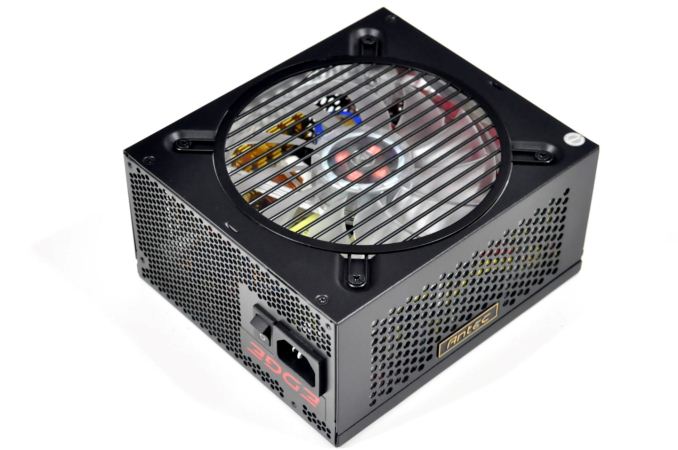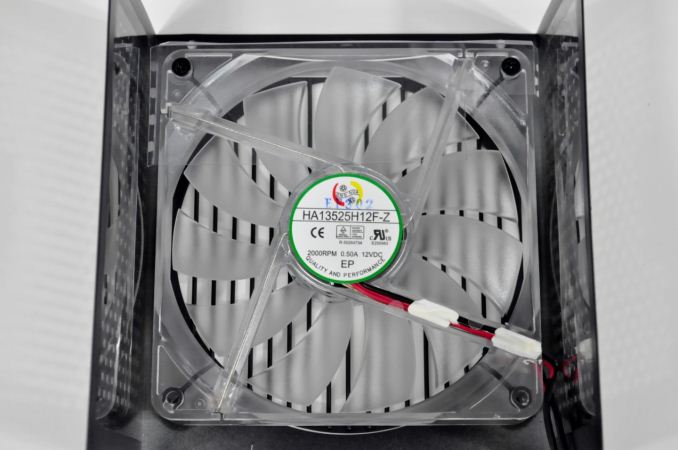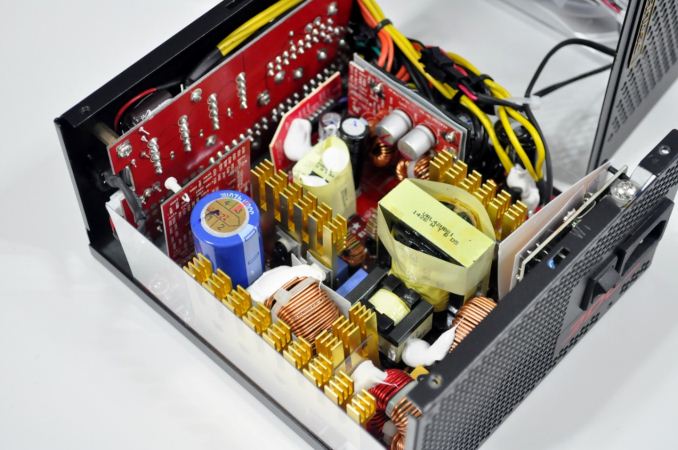Antec EDGE 550W Power Supply Review
by E. Fylladitakis on October 3, 2014 10:00 AM EST- Posted in
- Cases/Cooling/PSUs
- Antec
- 550W
- Edge
External Appearance
Visually, the Antec EDGE 550W certainly stands out from the crowd. Actively cooled units with perforated sides are rare to begin with, let alone units with an output of just 550W. This is likely to be more of a decorative measure than anything needed for cooling, as a large portion of the openings are blocked by the plastic shielding. Despite the output, the chassis of the Edge is 170mm long, making it slightly longer than a standard ATX unit and that could pose a problem in very tight compartments.
Antec made numerous small modifications to enhance the appearance of the unit, including a parallel grid fan guard, badges on the sides and rear of the chassis, and a semi-transparent white LED fan. The badges on the sides are installed in such a way that their orientation when looking at the unit from a left side panel window will be correct, regardless of whether the unit has been installed with the fan facing upwards or downwards. On the front side of the chassis are the connectors for the modular cables, as well as a switch that can turn the LED lighting off.
Internal Design
The 135mm semi-transparent fan is supplied by Hong Hua, a common supplier of fans for use in PSUs. It has a fluid dynamic bearing engine and a maximum speed of 2000RPM. Our instrumentation reports a maximum unobstructed volume flow of 70.5CFM.
Seasonic is the company behind the creation of the Antec's EDGE series. The EDGE shares the same platform as the Seasonic S12G but there are notable differences in the selection of components. There are four heatsinks, with the smallest one holding the primary rectifier bridge, the one near the edge of the PCB the active PFC components, and those on each side of the main transformer handle the inversion and conversion transistors of the primary and secondary stage respectively.
A small shielded PCB is attached to the rear of the AC receptacle, housing some of the filtering stage components, while the rest can be found on the main PCB. There are a total of six Y capacitors, two X capacitors and two filtering inductors, which are more than adequate for a good filtering stage. Moving towards the APFC stage, we see the blue Hitachi 330μF/420V capacitor next to a large filtering coil that has been drenched in glue. The rest of the capacitors are a mix of Nippon Chemi-Con and Rubycon electrolytics, as well as many polymer capacitors from Enesol.
The build quality of the Antec EDGE 550W is outstanding. Not only is the soldering job flawless, but the factory also performed an excellent assembly job. Glue has been applied on all critical components, ensuring the mechanical cohesion of the unit and minimizing the risk of high frequency vibration noises (also known as "coil whine"). Plastic sheets and pins ensure that no component will short another. Our only complaint lies with the design. As this platform has not really been developed purely for fully modular designs, there are a lot of cables causing some clutter near the left edge of the unit.

























25 Comments
View All Comments
mindbomb - Friday, October 3, 2014 - link
This seems like a pretty good psu. Should be enough for an i7 5820k and single gtx 980, with plenty of room left for overclocking.just4U - Friday, October 3, 2014 - link
The very first thing I look for in power supply reviews is which company is the manufacturer. Some you trust, some your iffy about and others you simply try to avoid. It's sometimes very hard to get that information and companies tend to jump from one manufacturer to the next in the middle of a products life cycle which makes it even harder.I am very pleased to see Antec (and Cooler Master come to think of it..) partnering up with Seasonic. It means I will be buying a lot more of their Power Supplies. I am also pleased to see Antect paying more attention to their cabling. It's always been a bone of contention for me and fully sleeved cables with no multi colored wires is always a plus.
Since I am pretty confident that someone at Antec will read this.. You dropped the ball on a lot of your casing designs of late. The Sonata needs a overhaul and the Lanboy should be a top seller if it's based on it's old Super Lan boy Aluminum design with slight modifications to factor in new cooling and cable management. ( a Removable MB Tray would be nice for enthusiasts to..) It's really not rocket science to figure out.
Take the Sonata redesign Throw in a power supply like this one and you got a win/win. The Sonata was billed as quiet but yeah.. no it wasn't still it's a popular casing that does need a minor refresh as well..
Anyway E. Great review.
Alexvrb - Friday, October 3, 2014 - link
I've got a Solo II (part of their Sonata lineup) that's pretty quiet, and has excellent build quality. The HDD suspension system is nice too, as is the SSD mount location. It's probably one of the shortest cases that supports full ATX boards and large graphics cards without major flaws or an insane price tag. With that being said I do feel they could improve on it a bit. But for its size they did quite well.Alan G - Friday, October 3, 2014 - link
So I can get a Seasonic G550 for about $40 less than this Antec/Seasonic PSU. I also get the same 5 year warranty on the unit and it's Gold plus certified. How do Antec expect to sell their branded Seasonic PSU?Daniel Egger - Friday, October 3, 2014 - link
It's good to see the reviews finally moving from insanely crazy to regular overkill but 550W is still way out of range of what an average user needs and that's even including a heavy duty graphics card, for those 350W are more than plenty. For "average" by that definition I'd like to see a review of a Seasonic X-400FL Platinum or a similarly good performer. The only point I can see in going for overkill is the better optimum efficiency at medium loads and quite frankly the Antec is simply not that good at this rating and price point...CknSalad - Friday, October 3, 2014 - link
Antec only makes good PSUs now and even then they can be quite expensive compared to the competition (even SeaSonic). I remember back when Antec was the brand for computer cases with their 900, 300, and sonata series. It's sad to see a once big-name company like Antec be a shadow of their former selves.romrunning - Friday, October 3, 2014 - link
Thanks for giving us a review on a lower-rated (less than 1kW) power supply! I really appreciate it - these are what I use when building my mini-ITX cases! Well, I also use SFX PSUs like the one Silverstone supplies.I would also love to see a test of some common GPUs (single, not SLI/Crossfire configs), Intel i5-i7s, and what is really needed to power such "common" systems.
romrunning - Friday, October 3, 2014 - link
Also, thanks for calling out the price. $120 is a bit steep for a budget/mainstream gaming build.Daniel Egger - Friday, October 3, 2014 - link
H81/87, Core-i5/7-4xxxS, SSD and GTX 750 Ti OC, BD-ROM are (at the wall) < 30W idle and around 130W if you throw FurMark and wPrime at it; that's already after the loss of the power conversion. You do the math...bsim500 - Saturday, October 4, 2014 - link
"I would also love to see a test of some common GPUs (single, not SLI/Crossfire configs), Intel i5-i7s, and what is really needed to power such "common" systems."As Daniel Egger said - far less than most people think. I have an i5-3570, even OC'd to 4GHz under Prime doesn't break the 100w barrier. Idle's at 37w (with discrete GPU which falls to 26w iGPU only), and it's not even a Haswell. Throw in an efficient nVidia Maxwell based GFX card (eg, 750Ti) and run Prime + Furmark and you're still under 150w under unrealistic synthetic "double power virus" conditions. For most normal gaming, it's nearer 80-120w (for a rig that can run most games at 1080p on console equivalent "Medium" setting) and wouldn't even use 50% capacity of a Seasonic G360. For high end gaming rigs, even a new GTX 970 would remain under 300w (maybe nearer 250w if you undervolted it a little) and easily function off of a decent 500-550w PSU at 50-60% PSU capacity.
For non gaming rigs, it's more like 40-70w just browsing the web & using office, 100w max full video encoding, etc, and that could easily run off a Pico-PSU laptop style power brick. All above figures on my rigs are measured at the wall with a kill-a-watt on Gold rated Seasonics, not merely 'calculated' from TDP, etc.